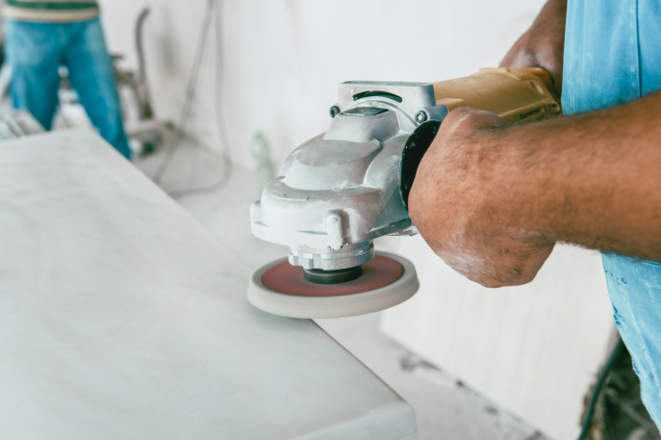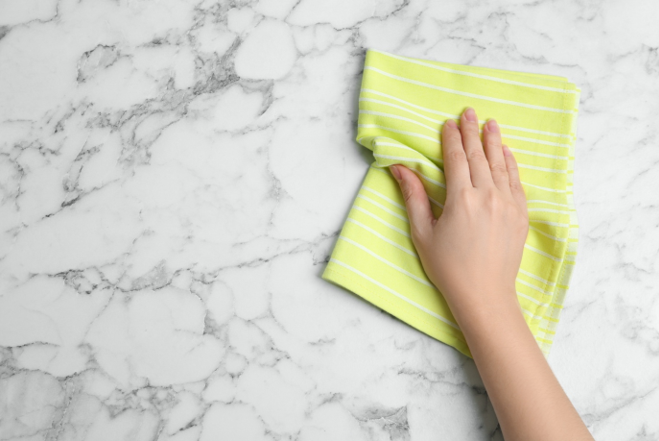What Is Marble Restoration?

What Is Marble Restoration?
Marble has always been admired for its elegance and timeless appeal, in design and architecture. It is renowned for its beauty and durability. However, like all materials, marble is susceptible to wear and tear, stains, and other forms of damage that can diminish its luster over time. This is where marble restoration becomes essential.
In this blog post, we will explore the steps undertaken by a stone restoration expert when restoring your marble surfaces. Additionally, we will provide you with some tips to help you maintain the glory of your marble.

Understanding Marble
Before delving into the intricacies of the restoration process, it is crucial to have a grasp on the nature of marble itself.
Marble is a type of rock composed mainly of recrystallized carbonate minerals such as calcite or dolomite. Each piece of marble possesses veining patterns that contribute to its beauty.
Marble comes in various colors, each with its distinct characteristics, such as the intensity of veining. Some of the most loved and used types of marble globally include Carrara, Statuary, Calacatta, Emperador, and Crema Marfil.
Despite its beauty, all types of marble are susceptible to etching from acidic materials and can be prone to scratching and staining, if not properly and regularly maintained.
Marble Restoration Process
- Evaluation
To begin the restoration process for marble, the first step is to inspect the surface. A professional stone restoration expert will carefully examine the marble for any stains, scratches, etching marks or structural damage. They will also analyze various factors such as the type of marble being worked on and its unique characteristics when determining the restoration approach.
- Preparation
Once the evaluation is completed, the preparation stage begins. During this phase, the stone restoration expert will methodically clean the marble surface to eliminate any dirt, grime or previous coatings that could interfere with the restoration process. Special precautions are taken to ensure that the surface is clear of contaminants that might have an impact on the restoration process, and the area surrounding the marble is protected, to prevent damage to nearby surfaces during the restoration process.
- Cleaning
The following step in the restoration process is the cleaning of the marble surface. In this step, gentle cleaners and non-abrasive tools are used to remove surface dirt and grime.. A pH-neutral solution is used for deeper cleaning to remove embedded dirt and stains without damaging the marble. Moreover, the stone restoration expert will avoid using acidic or abrasive cleaners that can etch or scratch the surface.
- Honing
When it comes to restoring marble surfaces that have gotten dull or scratched over time, honing is essential. To smooth out the marble surface and get rid of any etching, dullness, or scratches, special diamond pads are used in this stage. Usually, this process employs diamond pads with finer grits until the desired level of shine and smoothness is achieved to gradually improve the marble surface.
- Repairing
In cases where there are damaged areas on the marble surface, repairing them is the step in the marble restoration process. This may involve filling chips, cracks, or holes with an epoxy resin that matches the colour of the marble. For structural repairs such as broken corners or edges, specific techniques and materials can be used to support and fix the marble.
- Re-polishing
The last stage of the marble restoration process is re-polishing, which is crucial to accentuating the marble’s inherent beauty. For achieving a glossy and smooth surface, abrasive chemicals are used in this process. In addition to improving the marble’s color and veining, re-polishing also safeguards it against stains and etching in the future.
- Sealing
To provide a protective measure against external elements, stains, and moisture, sealing is an essential aspect of the marble restoration process. When sealing the marble surface, a top-of-the-line penetrating sealer is applied, penetrating its pores. By doing this, liquids are repelled and kept from penetrating into the marble which is important to lower the chances of future etching and staining.
Tips for Marble Maintenance
To preserve the beauty of your marble surfaces it’s crucial to follow maintenance practices. Below are some helpful tips from us:
- Regular Cleaning: Use a gentle, pH-neutral cleaner and a soft cloth or mop as a part of your regular cleaning schedule. Steer clear of abrasive cleansers and aggressive chemicals as they might cause damage to your marble surface.
- Immediate Stain Removal: Clean up spills and stains right away to keep them from penetrating into the marble. Using a cloth, gently dab spills without rubbing too hard so you are not spreading any possible stains.
- Cleaning Techniques: When cleaning your marble surfaces, use non-abrasive cleaners and soft cleaning tools as abrasive or acidic cleaners can etch your marble’s surface.
- Avoid DIY Projects: While it may seem tempting to try restoring your marble as a cost saving measure it can actually end up being quite expensive, if not done correctly. It’s advisable to steer away of DIY methods or kits and instead consider seeking the assistance of an expert for complex restoration tasks.
The Importance of Professional Assistance
While homeowners can take care of maintenance on their stone surfaces, seeking help from an expert is crucial when it comes to restoring marble.
Professional stone restoration experts have the skills and expertise to assess the condition of your marble surfaces and determine the best restoration methods based on the type of damage and unique characteristics of the marble.
In addition, professional stone restoration companies have access to specialised tools and equipment made specifically for marble restoration, which can have a big impact on the quality of the restoration work and are usually out of reach for homeowners. While a do-it-yourself marble restoration project might seem affordable at first, if mistakes are made along the way, it can soon become very costly and highly time-consuming. Utilising expert restoration services guarantees both cost and quality because the work is done right the first time.
Finally, knowing that experts are caring for your marble gives you piece of mind. Professional marble restoration services provide long-lasting effects that improve the beauty and ensure longevity of your marble surfaces.
Conclusion
Marble is a stone that requires a step-by-step restoration process involving specialized techniques and tools. By understanding these techniques, properly maintaining your marble, and seeking an expert’s assistance when needed, you can guarantee the long-term beauty and functionality of your marble surfaces.
iStone Care, Sydney’s premier stone restoration service is committed to delivering results that surpass your expectations for any marble surface. Get in touch with us today at 0452 029 949 or leave an enquiry to discuss your marble restoration needs and schedule a consultation with our experts.
